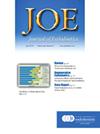Comparison of the Accuracy and Efficiency of Two Dynamic Navigation System Workflow for Fiber-post Removal: Small versus Large Field-of-view Registration Workflows
IF 3.5
2区 医学
Q1 DENTISTRY, ORAL SURGERY & MEDICINE
引用次数: 0
Abstract
Introduction
This study investigates the feasibility of a dynamic navigation system (DNS) small field of view workflow (DNS-SFOVw) for fiber-post removal and compares its accuracy and efficiency to the conventional large field of view workflow (DNS-LFOVw).
Methods
Fifty-six extracted human maxillary molars were divided into DNS-SFOVw (n = 28) and DNS-LFOVw (n = 28). The palatal canal was restored with an intraradicular RelyX fiber post and luted with RelyX Unicem; a core buildup was used. Teeth were mounted in a 3D-printed surgical jaw. A preoperative cone-beam computed tomography (CBCT) scan was taken with a 40 × 40 mm FOV for the DNS-SFOVw and a single arch CBCT scan for the DNS-LFOVw. The drilling entry point, trajectory, angle, and depth were planned in the X-guide software. The DNS registration method for the DNS-SFOVw was virtual-based registration on teeth, and the marker point-based method was used for the DNS-LFOVw. The fiber posts were drilled out under DNS guidance. A postoperative CBCT scan was taken. Three-dimensional deviations, angular deflection, number of mishaps, registration, and total operation time were calculated.
Results
The DNS-SFOVw was as accurate as DNS-LFOVw (P > .05). The DNS-LFOVw registration time was less than DNS-SFOVw (P < .05). There was no difference in the number of mishaps (P > .05). Both DNS-SFOVw and DNS-LFOVw were time-efficient, with DNS-LFOVw taking less total operational time (P < .05).
Conclusion
Within the limitations of this in-vitro study, the DNS-SFOVw was as accurate as the DNS-LFOVw for fiberpost removal. Both DNS-LFOVw and DNS-SFOVw were time-efficient in removing fiber-posts.
比较两种动态导航系统工作流程在纤维桩移除方面的准确性和效率:小视野与大视野注册工作流程。
导言:本研究探讨了动态导航系统(DNS)小视野工作流程(DNS-SFOVw)用于纤维桩拔除的可行性,并将其准确性和效率与传统的大视野工作流程(DNS-LFOVw)进行了比较:56颗拔出的人类上颌磨牙被分为DNS-SFOVw(28颗)和DNS-LFOVw(28颗)。用 RelyX 纤维桩修复腭管,并用 RelyX Unicem 树脂灌注;使用核心堆积。牙齿安装在 3D 打印的手术颌中。术前进行锥束计算机断层扫描(CBCT),DNS-SFOVw 的扫描范围为 40 x 40 mm,DNS-LFOVw 的扫描范围为单弓 CBCT。钻孔的切入点、轨迹、角度和深度均在 X-guide 软件中进行了规划。DNS-SFOVw 的 DNS 套准方法是基于牙齿的虚拟套准,而 DNS-LFOVw 则是基于标记点的方法。纤维桩是在 DNS 引导下钻出的。术后进行 CBCT 扫描。计算了三维(3D)偏差、角度偏差、失误次数、注册和总手术时间:结果:DNS-SFOVw 与 DNS-LFOVw 一样精确(P>.05)。DNS-LFOVw 登记时间少于 DNS-SFOVw(P.05)。DNS-SFOVw 和 DNS-LFOVw 都很省时,DNS-LFOVw 的总操作时间更短(p 结论:在这项体外研究的限制条件下,DNS-SFOVw 与 DNS-LFOVw 在纤维桩移除方面的精确度相当。DNS-LFOVw 和 DNS-SFOVw 在清除纤维桩方面都很省时。
本文章由计算机程序翻译,如有差异,请以英文原文为准。
求助全文
约1分钟内获得全文
求助全文
来源期刊

Journal of endodontics
医学-牙科与口腔外科
CiteScore
8.80
自引率
9.50%
发文量
224
审稿时长
42 days
期刊介绍:
The Journal of Endodontics, the official journal of the American Association of Endodontists, publishes scientific articles, case reports and comparison studies evaluating materials and methods of pulp conservation and endodontic treatment. Endodontists and general dentists can learn about new concepts in root canal treatment and the latest advances in techniques and instrumentation in the one journal that helps them keep pace with rapid changes in this field.
 求助内容:
求助内容: 应助结果提醒方式:
应助结果提醒方式:


